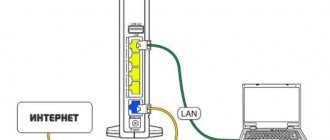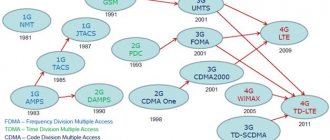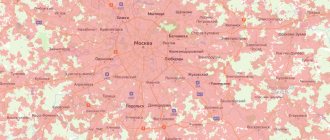Bandwidth
- metric characteristic showing the ratio of the maximum quantity
Used in various fields:
- in communications and computer science, P.S. is the maximum achievable amount of passing information;
- in transport PS - the number of transport units;
- in mechanical engineering - the volume of passing air (oil, grease);
- in electromagnetism (optics, acoustics) - the ratio of the energy flow passing through a body to the flow that falls on this body. The sum of transmittance, absorptivity and reflectance is equal to unity (see also Transparency of a medium
). - in hydraulics - Capacity (hydraulics)
.
Can be measured in various, sometimes highly specialized, units - pieces, bits/s, tons, cubic meters, etc.; in optics - a dimensionless quantity.
In computer science, the definition of throughput usually applies to a communication channel and is defined as the maximum amount of information transmitted or received per unit of time. Bandwidth is one of the most important factors from a user's point of view. It is estimated by the amount of data that the network can, in the limit, transfer per unit of time from one device connected to it to another.
Channel capacity
The highest possible information transmission speed in a given channel is called its throughput. Channel capacity is the speed of information transmission when using the “best” (optimal) source, encoder and decoder for a given channel, so it characterizes only the channel.
Nominal speed - bit rate of data transfer without distinction between service and user data. Effective speed - user data (load) transfer speed. This parameter depends on the ratio of overhead to useful data.
Throughput of a discrete (digital) channel without interference
where m
— the basis of the signal code used in the channel.
The speed of information transmission in a discrete channel without noise (ideal channel) is equal to its capacity when the symbols in the channel are independent and all m
symbols of the alphabet are equally probable (used equally often). Vt is the symbolic transmission rate.
Neural Network Bandwidth
The throughput of a neural network is the arithmetic average between the volumes of information processed and created by the neural network per unit of time.
The task arose to measure the throughput of an Ethernet channel and provide a report, and the measurements needed to be carried out within 24 hours. In what ways can this be done?
Using the iperf tool is very simple: on one side of the channel, a server is launched on the computer, which waits for a connection from the client:
On the other side of the channel, a client is launched on another computer indicating the server ip:
As we can see from the report, the throughput was measured for 10 seconds and amounted to 28.2 Gbit/s (the speed is so high because both the server and the client were run on the same computer). Great, but we need to measure the speed all day long. We look at the iperf –help parameters and find a bunch of useful information there. In the end I ended up with something like this:
The -t 86400 option specifies the measurement time in seconds, and the -i 15 option tells it to produce a result every 15 seconds. It’s already better, but it’s not entirely convenient to view such a report for a whole day (such a report will have 86400/15=5760 rows). Let's look at help further and see that iperf can provide a report in the form:
Great! Exactly what is needed! Now iperf produces statistics that are convenient for processing. Parameters in the report are separated by commas. The first column is the date and time, then the IP addresses and ports of the client and server are visible, and at the end the throughput in bits/s. Let's redirect this report to a file:
What is communication channel capacity?
In order to familiarize yourself with and understand the new term, you need to know what a communication channel is. In simple terms, communication channels are devices and means through which data (information) is transmitted over a distance. For example, communication between computers is carried out using fiber optic and cable networks. In addition, a common method of communication is via a radio channel (a computer connected to a modem or a Wi-Fi network).
Bandwidth is the maximum speed of information transmission in one specific unit of time.
Typically, the following units are used to indicate throughput:
Unit of information
Kilobit (or kilobyte)
Megabit (or megabyte)
Wi-Fi standards
Wi-Fi networks are described by IEEE 802.11 communication standards, dating back to 1997. The standards 802.11a and 802.11b appeared in 1999 (the first devices based on 802.11a were released in 2001), 802.11g in 2003, 802.11n in 2009, 802.11ac in 2014 and 802.11ax in 2021. A considerable number is obtained and so as not to get confused in For the average user, it was decided to give the standards alternative, easy-to-remember names. So in 2021, more convenient designations appeared: 802.11n became Wi-Fi 4, 802.11ac became Wi-Fi 5, and 802.11ax became Wi-Fi 6.
The fourth version (802.11n) operates in the 2.4 GHz and 5 GHz bands (most devices in this standard operate at 2.4 GHz) and is the most widespread at the moment. The maximum theoretical speed of 802.11n when using one antenna is up to 150 Mbps, and when using four – up to 600 Mbps. Available channel widths are 20 and 40 MHz.
Wi-Fi 5 (802.11ac) , released in 2013, operates only at 5 GHz. The maximum speed of 802.11ac when using eight MU-MIMO antennas can reach up to 6.77 Gbps, and among the main differences from the previous standard are:
- Supports channels with widths of 20, 40, 80 and 160 MHz.
- Support for 256QAM modulation, which gives an increase in speed of up to 33% compared to 64QAM used in Wi-Fi 4.
- Supports up to 8 spatial streams (Wi-Fi 4 supports up to 4).
- Fully working between equipment from different Beamforming manufacturers.
- Support for MU-MIMO (appeared in the second edition of the 802.11ac (Wave 2) standard).
The last two technologies will be discussed in more detail below.
Wi-Fi 6 (802.11ax) is the latest Wi-Fi standard released at the moment. The number of devices that support it is still small, but it is constantly increasing.
The maximum theoretical speed stated for Wi-Fi 6 is up to 11 Gbps. It operates at frequencies of 2.4 and 5 GHz, supports channel widths up to 160 MHz, and also introduced new technologies - OFDMA, 1024QAM modulation, BSS Coloring, Target Wake Time. You can read more about the sixth version in the article “Wi-Fi 6 802.11ax: Target Wake Time, BSS Coloring, OFDMA“.
Bandwidth Measurement
Measuring throughput is a fairly important operation. It is carried out in order to find out the exact speed of your Internet connection. The measurement can be done using the following steps:
- The simplest is to download a large file and send it to the other end. The disadvantage is that it is impossible to determine the accuracy of the measurement.
- In addition, you can use the resource speedtest.net. The service allows you to measure the width of the Internet channel “leading” to the server. However, this method is also not suitable for holistic measurement; the service provides data about the entire line to the server, and not about a specific communication channel. In addition, the object being measured does not have access to the global Internet.
- The optimal solution for measurement is the client-server utility Iperf. It allows you to measure time and the amount of data transferred. After the operation is completed, the program provides the user with a report.
What is the difference between Wi-Fi channel width 20 and 40
What is H and 4G - what is the difference between technologies
Now it’s worth figuring out what Wi-Fi bandwidth is 20 or 40 MHz, and which is better. If we return to the previous example with the road and cars, then it is worth making a reservation. A wide canal, unlike a highway, is subject to more negative influence from external factors. It especially depends on the amount of interference and electromagnetic waves that are emitted by other household appliances in the house.
Important! So you should keep in mind: the wider the channel, the more it will interfere with the operation of other Wi-Fi networks, regardless of the frequency they use. The opposite is also true.
The router channel settings contain two parameters: 20 MHz and 40 MHz. What's the difference between them? It is believed that 20 MHz is a narrow channel, and 40 is a wide one. A number of devices allow you to select a parameter automatically. Switching will occur depending on the conditions of use.
This parameter determines not so much the speed of the Internet, but its stability and quality. This is especially true for panel apartment buildings, where up to 4 or more routers can be located on one floor.
Important! If a person is in such a house, then it is advisable to choose a width of 20 megahertz. If the user lives in his own home, then for maximum efficiency of the device, it should be set to 40 MHz.
For a WiFi specification operating at 5 GHz, you can even select a channel with a width of 80 MHz
Bandwidth Calculation
In order to find and calculate the capacity of a communication line, it is necessary to use the Shannon-Hartley theorem. It says: you can find the throughput of a communication channel (line) by calculating the mutual relationship between the potential throughput, as well as the bandwidth of the communication line. The formula for calculating throughput is as follows:
In this formula, each element has its own meaning:
- I– denotes the maximum throughput parameter.
- G – parameter of the bandwidth intended for signal transmission.
- As/An – noise to signal ratio.
The Shannon-Hartley theorem suggests that to reduce external noise or increase signal strength, it is best to use a wide cable for data transmission.
Which country to choose in Wi-Fi settings for maximum power
Wi-Fi signal strength can sometimes depend on the country selection in the router configuration interface. Sometimes router chip manufacturers impose some restrictions on the signals emanating from devices, since different countries have different laws and standards that regulate communication power.
Setting the width parameter in the router
For example, experts recommend setting Bolivia as the country of residence, but it is not a fact that by setting this parameter the signal will be increased, since manufacturers can limit this too.
If a person lives in an apartment, then in most cases, increasing the width or strength of the router signal will lead to a deterioration in the quality of communication. This is due to the fact that the waves will simply reflect off the walls and dampen themselves.
In conclusion, we can say that the width of the Wi-Fi communication channel is not always able to increase the quality of the connection and speed up access to the global network. It is necessary to use wider channels where there is no constant influence of external factors on the router.
Signal transmission methods
Today, there are three main ways to transmit signals between computers:
- Transmission over radio networks.
- Data transmission via cable.
- Data transmission via fiber optic connections.
Each of these methods has individual characteristics of communication channels, which will be discussed below.
The advantages of transmitting information via radio channels include: versatility of use, ease of installation and configuration of such equipment. Typically, a radio transmitter is used to receive and transmit data wirelessly. It can be a modem for a computer or a Wi-Fi adapter.
The disadvantages of this transmission method include unstable and relatively low speed, high dependence on the presence of radio towers, as well as the high cost of use (mobile Internet is almost twice as expensive as “stationary” Internet).
The advantages of data transmission via cable are: reliability, ease of operation and maintenance. Information is transmitted through electric current. Relatively speaking, a current at a certain voltage moves from point A to point B. A is later converted into information. The wires can withstand temperature changes, bending and mechanical stress very well. The disadvantages include unstable speed, as well as deterioration of the connection due to rain or thunderstorms.
Perhaps the most advanced data transmission technology at the moment is the use of fiber optic cable. Millions of tiny glass tubes are used in the design of the communication channels of the communication channel network. And the signal transmitted through them is a light pulse. Since the speed of light is several times higher than the speed of current, this technology has made it possible to speed up the Internet connection several hundred times.
The disadvantages include the fragility of fiber optic cables. Firstly, they cannot withstand mechanical damage: broken tubes cannot transmit a light signal through themselves, and sudden temperature changes lead to their cracking. Well, the increased background radiation makes the tubes cloudy - because of this, the signal can deteriorate. In addition, the fiber optic cable is difficult to repair if it breaks, so it has to be completely replaced.
Essential information about random variables
5.1 Necessary information about random variables
A random variable is one of the basic concepts of probability theory. Informally, a random variable is a variable that takes on certain values with certain probabilities.
A strict mathematical definition of a random variable is given within the framework of the axiomatics of probability theory.
Definition 5.1
Let be a set, be a family of its subsets, and
- contains an empty set;
- The complement of any subset of again lies in ;
- For any countable subfamily, the union and intersection again lie in .
Then it is called -algebra.
Example 5.1
Consider a segment and a set containing all intervals from the segment.
For it to be an -algebra, it must also contain all half-intervals, segments, and any countable unions and intersections of them. If a set does not contain other subsets than those listed, then it is called a Borel -algebra. Its elements are called Borel sets. Definition 5.2
Let be an -algebra on the set . A mapping is called a probability measure on if
- for all ;
- ;
- For any countable family , where for , we have
We will call the quantity the probability of the event occurring
.
Let us denote the probability of an event given that the event occurred. called conditional probability
and at is calculated by the formula:
The relationship between conditional probabilities is established by the following two important theorems.
Theorem 5.1
Let be random events, and , the events are pairwise inconsistent and for all .
Then Theorem 5.2 (Bayes' Theorem)
Let , are two random events.
Then Definition 5.3
A probability space is a triple, where
- — a certain set, the elements of which are called elementary outcomes;
- - some -algebra on the set; sets of are called events; each event consists in the implementation of one of the outcomes.
- is a probability measure on .
Definition 5.4
Let be a probability space.
A random variable is any function such that for any Borel set in the family there is its inverse image: . In other words, a random variable is a variable that takes on certain values with certain probabilities.
Definition 5.5
Random variables are called independent if for any Borel sets we have
Thus, the occurrence of one event does not change the probability of the occurrence of another event.
The most important characteristic of a random variable is its probability distribution. The law of distribution of random variables is a relationship that establishes a connection between the possible values of a random variable and their corresponding probabilities. If different values of a quantity form a finite or infinite sequence, then the probability distribution is given by specifying these values and their corresponding probabilities, that is, the probabilities of all events. Random variables of this type are called discrete.
The distribution law of a discrete random variable can be given:
- Analytically
- Tabular
- Graphically
In all other cases, the probability distribution is specified by specifying the probability for each actual probability value or each interval.
Definition 5.6
Let be a random variable, and the function satisfies the conditions:
Then the random variable is called continuous, and the function is called its probability density.
The distribution law of a non-continuous random variable can be given as:
- distribution function
of a random variable defined by the equality: ; - distribution density
, defined as the derivative of the distribution function: .
The distribution function is uniquely determined through the distribution density:
Properties of the distribution function:
- The distribution density takes only non-negative values: ;
- the area of the figure bounded by the distribution density graph and the abscissa axis is equal to one:
Numerical characteristics of random variables
Definition 5.7
Let be a probability space.
The mathematical expectation of a random variable is the quantity Here the set is considered as a union of events, the probability of which is .
Let's consider two important special cases.
For a discrete random variable taking values with probabilities , the value turns into an event consisting of one outcome. Then
For a continuous random variable with a density function in the integral, you can make a change of variable: . Then we will have:
Definition 5.8
The variance of a random variable is the number.
Again we are interested in two important special cases:
The variance of a random variable shows the spread of values relative to the mathematical expectation.
Markov chains
Definition 5.9
A Markov chain is a sequence of random variables such that for any values
In other words, a Markov chain is a sequence of random variables, each of which depends only on the previous random variable.
A Markov chain is associated with a certain quantity that takes random values at discrete times. Therefore, the outcome "" can be formulated in other words: "at the moment of time the circuit is in the state ".
If the set of states of all random variables in the aggregate is finite, then the chain is called finite
.
If the conditional probability does not depend on the number , then the chain is called homogeneous.
A finite homogeneous Markov chain is given by:
- a set of values that random variables can take;
- vector of initial probabilities with which the random variable takes values;
- a matrix of transition probabilities in which (i.e. the probability that the process will move from the state to the state); note that
Using the vector of initial probabilities and the transition matrix, you can calculate the stochastic vector - a vector composed of the probabilities that the process will end up in a state through steps. The correct formula is:
| ( 5.1) |
As vectors grow, in some cases they stabilize—they converge to a certain probability vector, which can be called the stationary distribution of the chain. Since it does not change from step to step, formula (5.1) is transformed into the following relation:
| ( 5.2) |
A Markov chain is often depicted as a transition digraph, the vertices of which correspond to the states of the chain, and the arcs correspond to transitions between them. The weight of the arc connecting the vertices will be equal to the probability of transition from the first state to the second.
Example 5.2
Let a discrete homogeneous Markov chain have a set of states, the probability distribution is determined by the vector, the transition probabilities are given by the matrix
Find:
- matrix of transition of a chain from state to state in two steps;
- probability distribution of states for at time ;
- the probability that at the moment the state of the circuit will be ;
- stationary distribution.
Solution.
- The transition matrix of a homogeneous Markov chain into steps is equal to . For two steps we have:
- Let's find the probability distribution at time . In formula (5.1) we substitute , and we get:
- Let's find the probability distribution at time . In formula (5.1) we substitute , and we get:
- Let us find the stationary distribution using condition (5.2). We have a system of equations:
The last condition is called normalization. In the system we have written down, one equation is always a linear combination of others. Therefore, it can be crossed out. Let's solve the first equation of the system and the normalization equation together. We have, that is. Then , or . Hence, .
Answer:
- the two-step transition matrix for a given Markov chain has the form
- the probability distribution over the states at the moment is equal to
- the probability that at the moment the state of the circuit will be equal to ;
- stationary distribution:
Average capacity of communication lines
From the above, we can conclude that communication channels differ in their properties, which affect the speed of information transfer. As mentioned earlier, communication channels can be wired, wireless or based on the use of fiber optic cables. The last type of creating data networks is the most effective. And its average communication channel capacity is 100 Mbit/s.
What is a beat? How is bit rate measured?
Bit rate is a measurement of connection speed. Calculated in bits, the smallest units of information storage, per 1 second. It was inherent in communication channels in the era of the “early development” of the Internet: at that time, text files were mainly transmitted on the global web.
Currently, the basic unit of measurement is 1 byte. It, in turn, is equal to 8 bits. Beginner users very often make a grave mistake: they confuse kilobits and kilobytes. This is where the confusion arises when a channel with a bandwidth of 512 kbps does not live up to expectations and produces a speed of only 64 KB/s. To avoid confusion, you need to remember that if bits are used to indicate speed, then the entry will be made without abbreviations: bit/s, kbit/s, kbit/s or kbps.
Difference in Mbit/s and MB/s
It is important to understand that bandwidth can be expressed in any units (bytes, kilobytes, megabytes, gigabits, etc.). Your ISP may use one term, your testing service another, and your video streaming service a third. You need to understand how all of these terms are related and how to convert between them if you don't want to pay for too much internet service or, worse, order too little for what you want to do with it.
For example, 15 MB is not the same as 15 MB (note the lowercase b). The first is 15 megabytes, and the second is 15 megabits. These two values differ by a factor of 8, since there are 8 bits in a byte.
If these two throughput values were written in megabytes (MB), they would be 15 MB and 1.875 MB (since 15/8 equals 1.875). However, when recording in megabits (MB), the first will be 120 Mbps (15x8 - 120) and the second will be 15 Mbps.
Factors affecting Internet speed
As you know, the final speed of the Internet depends on the bandwidth of the communication channel. The speed of information transfer is also affected by:
Radio waves, cables and fiber optic cables. The properties, advantages and disadvantages of these connection methods were discussed above.
The busier the server is, the slower it receives or transmits files and signals.
Interference has the greatest impact on connections created using radio waves. This is caused by cell phones, radios, and other radio receivers and transmitters.
- Status of network equipment.
Of course, connection methods, the state of servers and the presence of interference play an important role in ensuring high-speed Internet. However, even if the above indicators are normal, and the Internet speed is low, the problem is hidden in the computer’s network equipment. Modern network cards are capable of supporting Internet connections at speeds of up to 100 Mbit per second. Previously, cards could provide maximum throughput of 30 and 50 Mbps, respectively.
Which mode to choose
The so-called non-overlapping channels, which have specific numbers, will work best. You can determine them yourself by looking at the broadcast diagram, for example, of the 2.4 GHz band:
Initially, routers with this frequency mode can broadcast on all 14 channels, but some of them are reserved for social and government needs. For example, in the USA they officially use 11 channels. At the same time, formally, the laws of the United States do not prohibit civilians from using the 12th and 13th segments of the 2.4 GHz band in low-power mode. In the territories of Russia and Ukraine, all channels are available except 14. Devices purchased in different countries can see only those segments of the frequency range, the use of which is approved by the relevant legislation.
Based on the number of 13 channels available to Russians and Ukrainians, the 1st, 6th and 11th will work best. The width of the network segment is also determined by the wireless communication standard, which is also useful to consider when choosing this parameter.
For example, the minimum conditional channel width of the 802.11g and 802.11n specifications is 20 MHz, while its actual value has decreased to 16.25 MHz. This is due to modern signal modulation technologies. The spectrum of channels in the 2.4 GHz range with a width of 16.25 MHz no longer has 3, but 4 minimally overlapping segments with numbers 1, 5, 9 and 13.
Broadcasting at 5 GHz provides a significantly larger number of channels with identical initial bandwidth. This more modern wireless technology allows you to choose from 23 non-overlapping segments, available depending on the region of use. Such channels are usually highlighted in bold in the router settings.
Devices that support high broadcast speeds at 5 GHz are more expensive and less common. Therefore, radio noise and interference are less common on the air in this range. When the throughput increases to 40 or 80 MHz, the number of non-overlapping 5 GHz network segments will decrease to 10 or 5 channels, respectively.
If the device operates with a bandwidth of 160 MHz, which is achieved by combining two 80 MHz streams, the number of independent bands will be reduced to two.
The channel width of the 2.4 GHz band can be increased to 40 MHz, but this will reduce the number of minimally interoperable channels to one. If the router broadcasts using 802.11N and later Wi-fi specifications, the number of non-overlapping 40 MHz segments will increase to two - 3 and 11.
Modern wireless communication standards make it possible to increase the bandwidth to 80 and even 160 MHz, but this does not always contribute to the stability and quality of the connection. It should also be taken into account that the larger the channel width, the smaller the coverage area. You can determine the number of the least popular segment of the network range and other indicators of its operation using the following programs:
| Windows | MacOS | Linux | Android |
| InSSIDer | WiFi Scanner | LinSSID | AirScout Live |
| WirelessNetView | iStumbler | iwScanner | Wi-Fi Analyzer |
| Free Wi-Fi Scanner | WiFi Explorer | Wi-Fi Visualizer | |
| Acrylic WiFi Home | AirRadar | WiTuners Mobile |
In the range of 40 MHz or more, channel numbers can take the form of two digits with an addition or subtraction sign between them. They mean the main and auxiliary segments of the network, respectively. For a better understanding, it is recommended to represent the router broadcast streams in the form of arcs. If there is a plus sign between the numbers, then the main channel uses the left arc of the additional band, and if there is a minus sign, then the right one. The offset of interaction flows is determined by the router model. Example values:
- “9+5” - the router distributes the Internet from channel 9, additionally using the left area of band 5.
- “40-1” - the device broadcasts from segment 40 using the right arc of stream 1.
20 MHz
The value of one bandwidth in the 2.4 GHz band is 22 MHz, but in the settings this value is reduced to 20 MHz. Despite the lower bandwidth, in some situations this mode provides a stable and fast connection. It is supported by most devices, including older tablets and phones.
It is recommended to choose 20 MHz when the router’s coverage intersects with someone else’s broadcast. This will eliminate interference that can be found in multi-story buildings and offices with intensive Wi-Fi use.
2.4 GHz is the most popular mode. Routers with default settings can automatically select the highest bandwidth, which puts a heavy load on 40 MHz broadcasts. For the same reason, coverage with 20 MHz channels is often relatively free. By setting this channel length value in the router settings, you can provide at least 3 devices with high-quality broadcasting.
40 MHz
The 2.4 GHz band allows you to increase the bandwidth to 40 MHz, but this value will make the Internet inaccessible to gadgets whose Wi-Fi modules are limited to 20 MHz. Among the disadvantages of higher bandwidth is also the smaller number of devices that can simultaneously receive high-quality broadcasts from the router.
A channel width of 40 MHz is suitable as an alternative to automatic band selection or when there is no overlap with other coverage areas. In such conditions, it will be possible to provide one or two devices with high-speed Internet. 40 MHz also makes sense when using a mesh system - peer-to-peer coverage provided by two or more devices or repeaters.
20/40 MHz (auto)
This mode is set in the router’s factory configuration, so the device independently selects the optimal throughput. If the connection is fast and stable, then it is not necessary to specify specific channel width values.
20/40/80 MHz (auto)
This method of determining the range differs from the automatic selection between 20 or 40 MHz only in the presence of a third option. The value of 80 MHz is present in the configurations of more modern devices.











